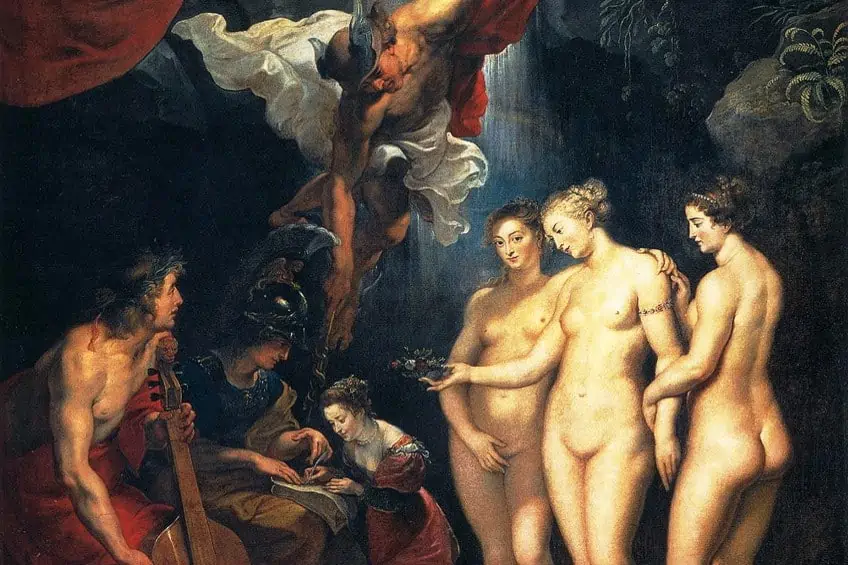Famous Baroque Paintings – The Best Baroque Period Artworks
Movement, grandeur, splendor, and drama – these are just a few features of Baroque artworks that also find roots in architecture and many other forms of 17th-century art. This article will introduce you to the nature of the Baroque art style as well as some of the most famous Baroque paintings of the 17th-century art sphere.
Contents
- 1 The Baroque Art Style
- 2 Top 10 Most Famous Baroque Paintings
- 2.1 Boy with a Basket of Fruit (1593) by Michelangelo Caravaggio
- 2.2 The Peasant Lawyer (c. 1620) by Pieter Brueghel the Younger
- 2.3 Education of Marie de Medici (1622 – 1625) by Sir Peter Paul Rubens
- 2.4 The Anatomy Lesson of Dr. Nicholaes Tulp (1632) by Rembrandt van Rijn
- 2.5 The Abduction of the Sabine Women (1633 – 1634) by Nicolas Poussin
- 2.6 Las Meninas (1656) by Diego Velázquez
- 2.7 The Triumph of the Name of Jesus (1661 – 1679) by Giovanni Battista Gaulli
- 2.8 Vanitas (1672 – 1676) by Franciscus Gysbrechts
- 2.9 Franche-Comté taken for the second time (1681 – 1684) by Charles Le Brun
- 2.10 Apotheosis of St Ignatius (1688 – 1694) by Andrea Pozzo
- 3 Famous Baroque Portraits
- 4 Other Influential Baroque Painters
- 5 Frequently Asked Questions
The Baroque Art Style
The origins of the Baroque art style can be traced back to the early 17th century in Europe and spans multiple disciplines, including music, architecture, dance, painting, poetry, and sculpture. This period lasted until the 1740s and included territories such as the Iberian Peninsula as well as the Portuguese and Spanish Empires.
The Baroque art style followed the art styles of the Mannerism, Neoclassical, and Renaissance movements, which were promoted by the Catholic Church as a solution to challenging the style of Protestant architecture.

Alongside the Catholic Baroque style existed the Lutheran Baroque style in different parts of Europe. The characteristics of the Baroque art style consisted of the use of contrast, immense detail, a sense of movement, deep colors, and an overall sense of awe. The Baroque art style is said to have begun in Rome and then reached France, Italy, Spain, Portugal, Austria, Germany, and then Russia.
As time progressed, the art style transformed into the Rococo style, which then lasted until the 18th century.
The Renaissance brought about the introduction of ornamental designs and decorative elements but the Baroque style introduced other elements made using stucco, carving, or marquetry such as the cartouche, fruit baskets, weapons, trophies, and flowers.
The Italian Baroque Painting Style
The Italian Baroque painting style finds its heritage in architecture and towards the end of the 17th century, it peaked and became known as the High Baroque style. Prominent figures like Pope Alexander VII and Urban VIII commissioned many monumental works in this style and were drawn to artists like Gian Lorenzo Bernini for creating grand sculptural works to complement and elevate the architecture of religious buildings.
Another important contribution to the Baroque style involved Italian Baroque artworks, often depicting hordes of saints and angels using architectural effects such as trompe-l’œil to reinforce the grandeur of the artworks.
The trompe-l’œil method refers to a painting style used to create an optical illusion or forced perspective to trick the observer into perceiving the imagery as real objects or spaces within the architecture. This was a significant feature of many Italian High Baroque paintings.
Top 10 Most Famous Baroque Paintings
The majority of Baroque painters strayed away from being categorized as Mannerist or Renaissance painters and made sure to include in their color palette primary colors with intense warm shades and avoided the seemingly balanced lighting seen in Renaissance paintings.
Many Baroque paintings feature strong contrasts between lightness and darkness in different parts of the painting to guide the viewer’s eye to focus on specific elements of the painting.
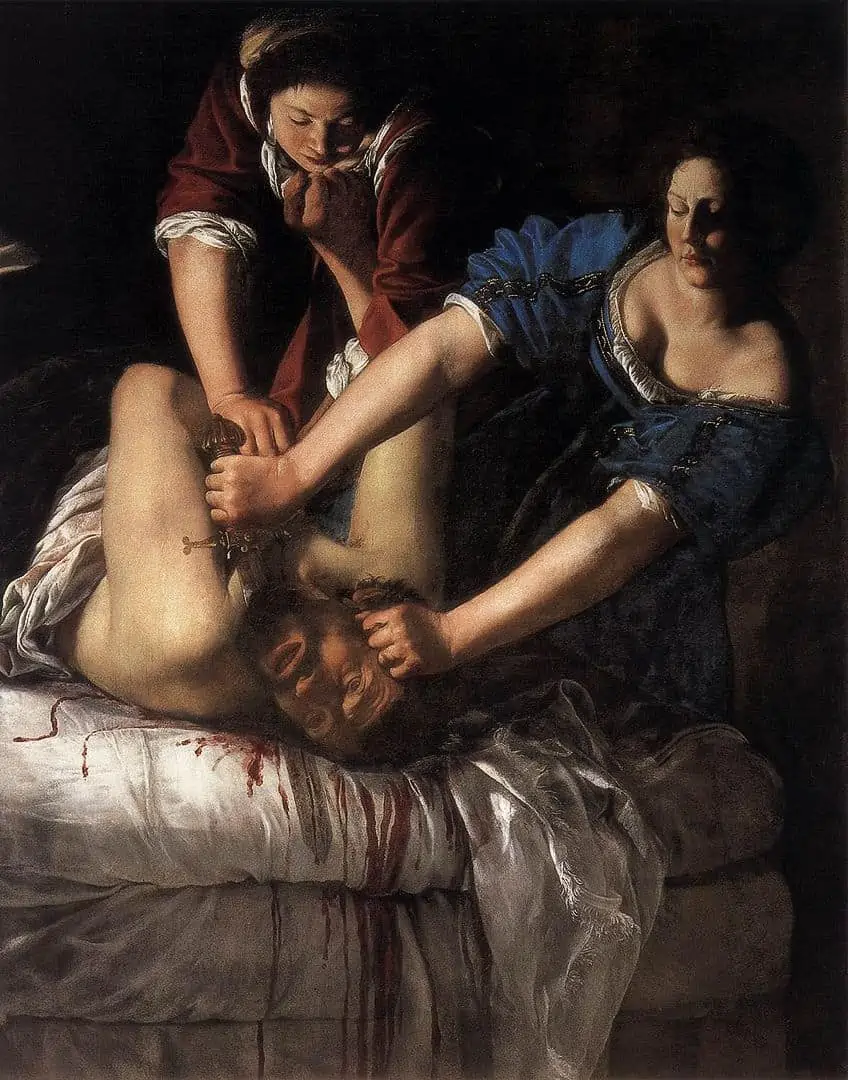
Other features that Baroque painters tried to avoid include depicting figures with well-put-together expressions and emphasizing the strong emotive nature of what the figures in these paintings were feeling. This adds to the drama and movement of the scenes in the Baroque paintings below.
Baroque painting often leverages asymmetry with movement placed away from the center of the scene and with axes that slant to the left and right to express instability, drama, and emotion.
Another important feature to build on the drama of a scene was for the artist to include a sense of movement through the illusion of wind blowing on the figures or figures moving along with the direction of the invisible wind. That being said, the last crucial feature of Baroque paintings included allegory meaning each artwork was embedded with a message and often encrypted with allegorical characters or symbols that the viewer was expected to read. Below, we will examine a few of the most famous Baroque paintings in art history.
Boy with a Basket of Fruit (1593) by Michelangelo Caravaggio
| Artist | Michelangelo Merisi da Caravaggio (1571 – 1610) |
| Date | 1593 |
| Medium | Oil on canvas |
| Dimensions (cm) | 70 x 67 |
| Where It Is Housed | Galleria Borghese, Rome, Italy |
This dramatic Baroque painting by Italian master Michelangelo Merisi da Caravaggio was painted around 1593 and depicts a boy holding a basket that appears filled with many fruits. According to an analysis of the basket, the fruits appear in excellent condition. The basket contains fruits such as four clusters of grapes, a ripe pomegranate, two medlars, four figs, three apples, pears, and a bi-colored peach. The leaves in the basket show different conditions that affected the fruits, including fungal spots and a mass of white insect eggs.
The figure holding the basket of fruit is said to be Mario Minniti, a 16-year-old friend of Caravaggio’s. The painting was meant to express sensuality, which was a common feature of many early Caravaggio paintings.
The handsome face of the boy who tilts his head while lowering his shirt off one shoulder while he presses the basket against himself alludes to his sensual nature. Many admired not only Caravaggio’s dramatic flair but more so his portrayal of the fruit, which appeared so realistic and detailed that it was hard to not look at the painting without being drawn to the colors of the fruit first.
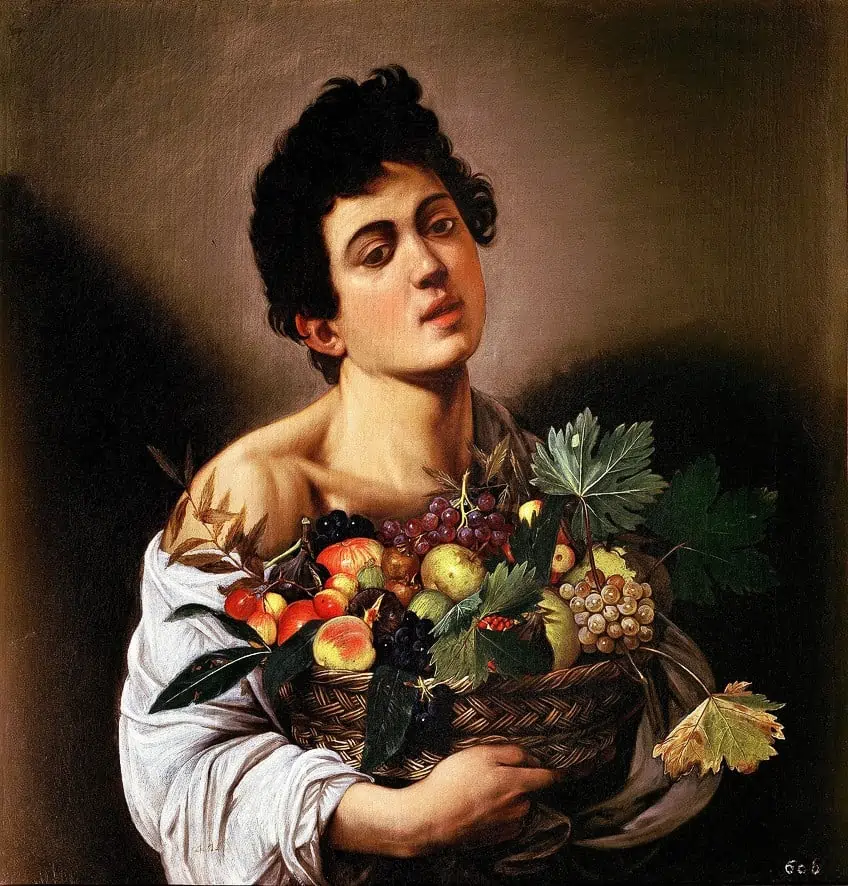
Caravaggio also paid extra attention to light and the use of color. The light appears to fall on the left side of the painting with the brightest portions of the boy’s face being his shoulder and cheek on the left. In contrast to this, the shadows fall on the right side with the background illustrating a gray wall alluding to the fact that this was a carefully orchestrated composition. Caravaggio held a great influence over the development of Baroque painting and made his mark by combining the perception of the realistic human state with dramatic lighting to portray both the emotional and physical aspects of a painting.
He often used chiaroscuro, also referred to as tenebrism, which uses strong contrasts of light and dark to inform a composition.
The Peasant Lawyer (c. 1620) by Pieter Brueghel the Younger
| Artist | Pieter Brueghel the Younger (1564 – 1636) |
| Date | 1622 – 1625 |
| Medium | Tempera on panel |
| Dimensions (cm) | 71.1 x 104.1 |
| Where It Is Housed | Grohmann Museum, Milwaukee, United States |
This famous Baroque painting by Pieter Brueghel the Younger is a classical example of a 17th century Flanders Genre painting that was intended to depict scenes from everyday life. Brueghel’s painting depicts figures with no said identity and appearing to be engaged in activities that were associated with the life of poorer citizens. The painting gained much popularity such that the minimum number of reproductions was 20 at the artist’s workshop. Today, more than 100 variants can be found in this painting, although not all were made by Brueghel the Younger.
The Peasant Lawyer (c. 1620) was dated using dendrochronology, also known as tree ring dating based on the panel.

The painting also amassed several different titles, including The Payment of Tithes and The Tax Collector. The scene seems to portray a village attorney’s office filled with clients lining up to use the service. The villagers appear humble as they approach the attorney’s desk and offer up different items as payment, including eggs and poultry in exchange for the lawyer’s services.
An hourglass can also be seen on the desk and is perhaps a symbol of fleeting time or commentary on the lawyer’s services as he bills people by the minute.
Education of Marie de Medici (1622 – 1625) by Sir Peter Paul Rubens
| Artist | Sir Peter Paul Rubens (1577 – 1640) |
| Date | 1622 – 1625 |
| Medium | Oil on canvas |
| Dimensions (cm) | 394 x 295 |
| Where It Is Housed | Louvre Museum, Paris, France |
Sir Peter Paul Rubens is considered one of the most prolific Flemish Baroque artists of all time and created this famous Baroque painting between 1622 and 1625. The painting illustrates Marie de’ Medici, who was the second wife of the French monarch, King Henry IV, and the Queen of France, surrounded by various mythological figures believed to be educating her on her duties as a queen.
The three Gods present are believed to be Athena, Apollo, and Hermes.
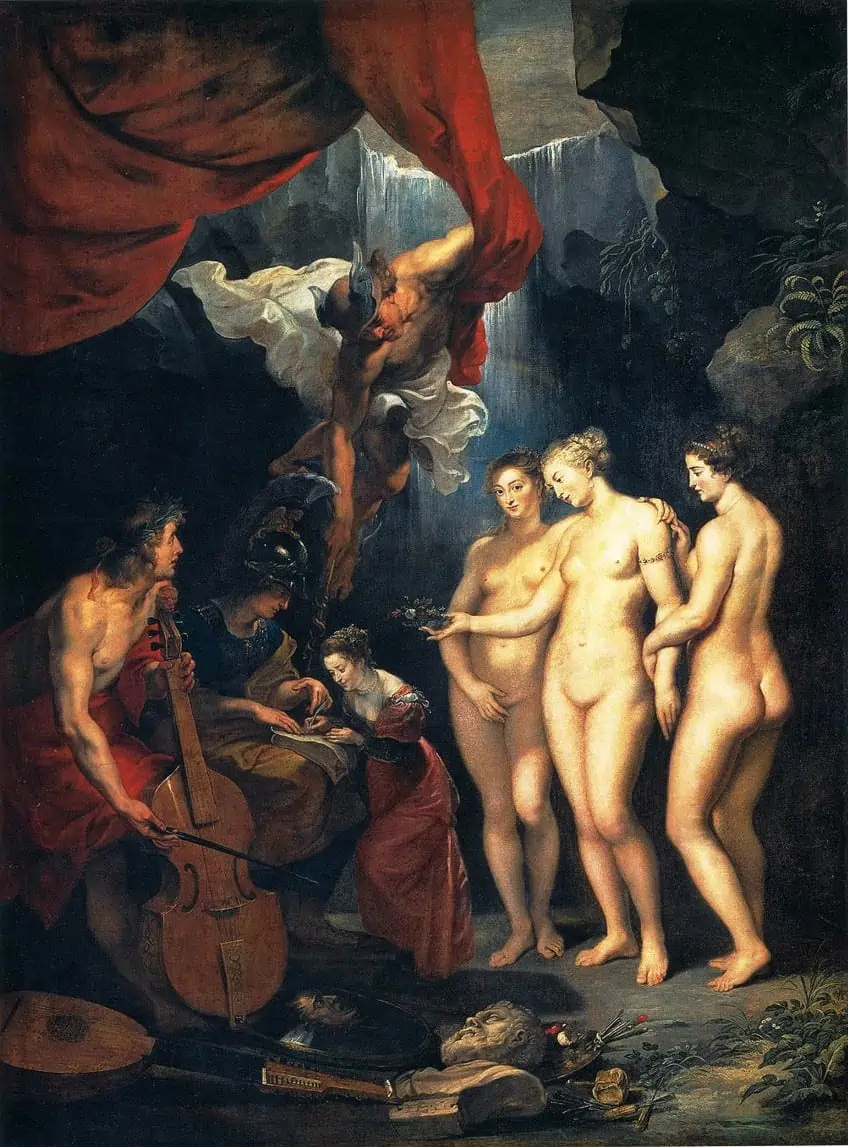
Marie de’ Medici is seen as a small figure at the feet of Minerva who provides her with insight into the basic elements of knowledge. Hermes teaches Marie eloquence while Harmony and the Graces introduce her to the polite arts. The foreground of the painting shows different tools for sculpture and instruments for painting.
There is also a stringed instrument, which represents music.
The Anatomy Lesson of Dr. Nicholaes Tulp (1632) by Rembrandt van Rijn
| Artist | Rembrandt Harmenszoon van Rijn (1606 – 1669) |
| Date | 1632 |
| Medium | Oil on canvas |
| Dimensions (m) | 1.7 x 2.16 |
| Where It Is Housed | Mauritshuis Museum, the Hague, Netherlands |
This 1632 masterpiece by Rembrandt van Rijn is one of the artist’s earliest known works and one of the most famous Baroque paintings in history. The painting illustrates Dr. Nicolaes Tulp, who was the mayor of Amsterdam and a Dutch surgeon, explaining a lesson on the anatomy of the human arm to a group of doctors. Some of the figures in the painting are individuals who paid a commission price to be included in the work.
The painting is also unique in that it may have been the first painting that Rembrandt signed with his forename, prior to his latter use of initials indicating that this was before he attained confidence as an artist.
The scene portrayed is dated to 31 January 1632 at the Amsterdam Guild of Surgeons where Tulp held the title of being the official City Anatomist and was allowed one public dissection each year. The corpse in the painting is said to be of an executed criminal. These public dissections were known to be a common 17th-century event that occurred in lecture rooms surrounded by members of the public, scholars, and colleagues who had to pay an entrance fee to spectate the event.
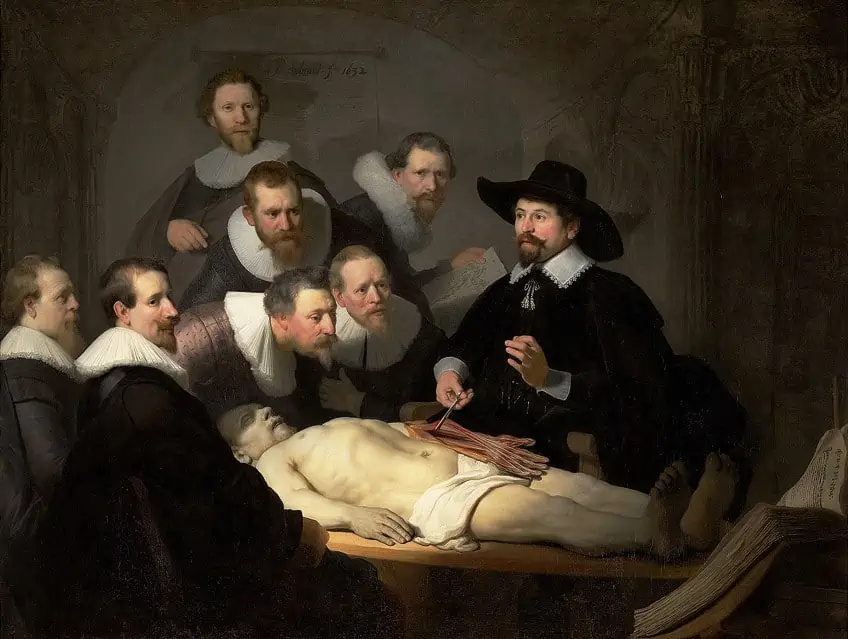
Every five or ten years, the association would commission a portrait by an artist of specialty and in 1632, it was Rembrandt who was selected when he was just 25 years old. Rembrandt’s execution of the painting significantly changed previous conventions of the scene as he included a full-length depiction of the corpse in the center, which can be compared to the iconography of Christ.
Not only was this a new take on the dissection portrait, but Rembrandt also provided a mise-en-scène. The scene presented was fictional since the lead surgeon would first begin the session by opening the body’s chest cavity and thorax.
The scene also negates the presence of any cutting tools since Tulp’s stature would have meant that there was already a preparator who prepared the body before the session. The bottom right corner shows a large textbook lying open, which is presumed to be a copy of Fabric of the Human Body (1543) by Andreas Vesalius.
The Abduction of the Sabine Women (1633 – 1634) by Nicolas Poussin
| Artist | Nicolas Poussin (1594 – 1665) |
| Date | 1633 – 1634 |
| Medium | Oil on canvas |
| Dimensions (cm) | 154.6 x 209.9 |
| Where It Is Housed | Metropolitan Museum of Art, New York City, United States |
Nicolas Poussin was a popular French Baroque painter and philosopher who drew inspiration from classical antiquity, Greek sculpture, and architecture. His ideals were founded on reasoning, balance, and proportion. A master of color and light, Poussin was also recognized as the least “Baroque” artist of his time since his paintings were not as dramatic as that of other Baroque artists.
The painting above illustrates the event that transpired in the Roman legend called the Abduction of the Sabine Women, which occurred during the reign of Romulus, the founder of Rome around 750 BC.
Historians Plutarch and Livy stated that the new settlement known as Rome was apparently short of women in the society and as a solution, the Romans organized a festival where they intended to kidnap the Sabine women. The result of the kidnappings ended in a fierce battle and eventually a peaceful resolution to unite with the Romans and form one nation. The 1633 painting of the scene was commissioned by Marshal de Crequi, a French diplomat. Poussin uses the underlying theme of “subdued mayhem” and illustrates the scene using a mix of vivid pinks, blues, reds, and oranges.
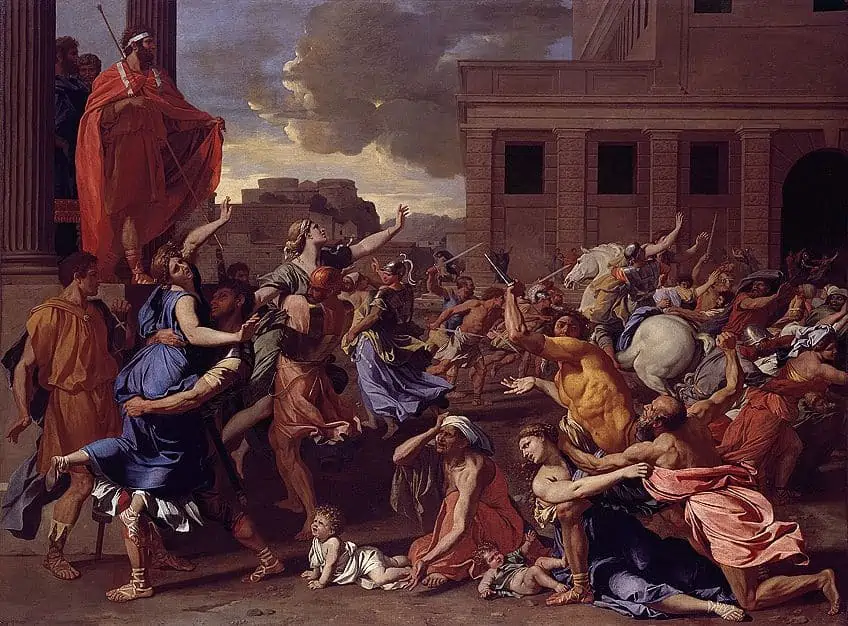
He organized the figures who appear caught in the struggle in seven layers that run parallel to the foreground. The colors coupled with the layered composition are what make the painting somewhat dramatic. Poussin went on to create two versions of this legend; one housed at the Metropolitan Museum of Art (seen above) and another later work (1637 – 1638) housed at the Louvre in Paris.
This version of the event was painted in a more controlled manner while the version at the Louvre evokes more depth and dynamism.
Las Meninas (1656) by Diego Velázquez
| Artist | Diego Rodríguez de Silva y Velázquez (1599 – 1660) |
| Date | 1656 |
| Medium | Oil on canvas |
| Dimensions (cm) | 318 x 276 |
| Where It Is Housed | Museo del Prado, Madrid, Spain |
Las Meninas (1656) translates to Ladies in Waiting and is a famous Spanish Baroque painting by Diego Velázquez who is one of the pioneering artists of the Spanish Golden Age. The painting is also on the list of the most analyzed paintings in Western art history due to the painting’s complexity and composition, which resulted in many questions on the relationships between the viewer and the figures as well as reality and illusion.
According to F. J. Sánchez Cantón, the painting illustrates the main chamber of the Royal Alcazar in Madrid. At the time, King Philip IV of Spain was the ruler and the painting showcases several individuals identified to be members of the Spanish court.
Many share the notion that the painting was illustrated in a way that implies it was a snapshot of a moment, like a photograph, and quite ahead of its time. A few of the figures in the scene look directly at the viewer while others seem to interact with each other.
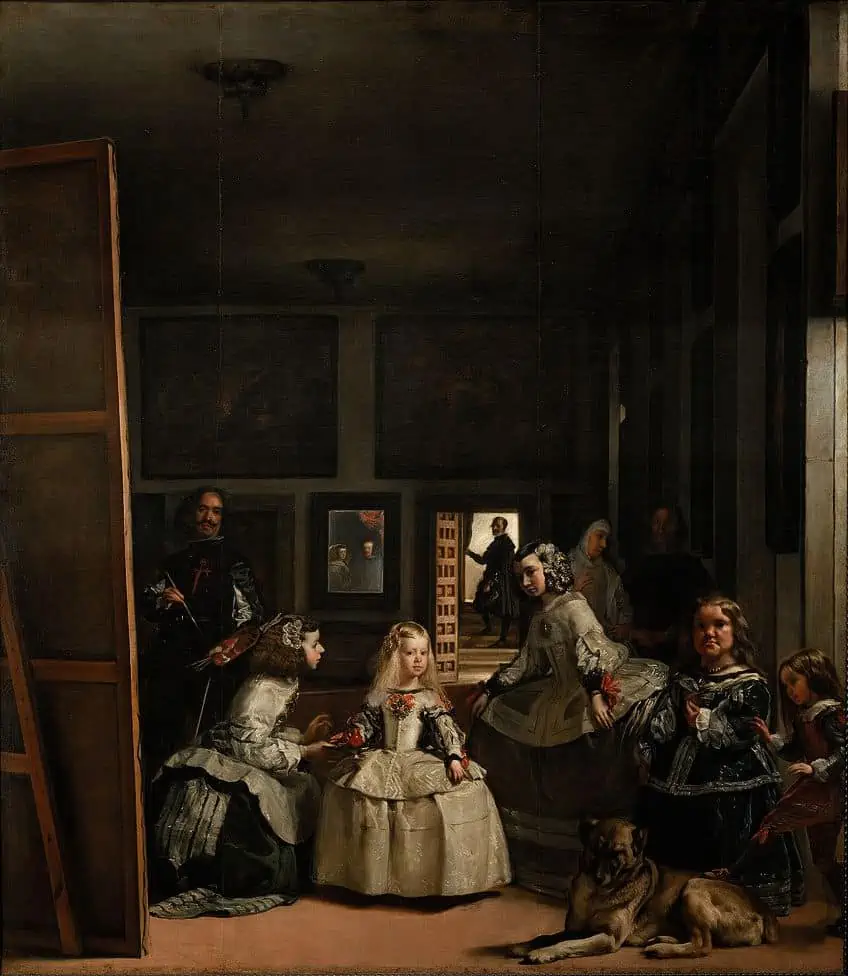
The central figure is Margaret Theresa, a five-year-old girl surrounded by multiple maids of honor, including a chaperone, a dog, a bodyguard, and two dwarfs. Behind the young girl, Velázquez painted himself working on a canvas, peering outwards, beyond the pictorial plane and towards the direction of the viewer.
There is also a mirror in the background that shows the reflections of the upper halves of the King and Queen, suggesting their presence outside the pictorial space but also in the position of the viewer.
These peculiar angles and gazes to create imaginary spaces make one question the role of the viewer and that perhaps the position of the viewer is more crucial to the digestion of the painting than the actual painting itself. Another Baroque artist, Luca Giordano claimed that the painting was a representation of the theology of painting and it was later described as the “true philosophy of art” and a “supreme achievement”. What do you think?
The Triumph of the Name of Jesus (1661 – 1679) by Giovanni Battista Gaulli
| Artist | Giovanni Battista Gaulli (1639 – 1709) |
| Date | 1661 – 1679 |
| Medium | Fresco |
| Dimensions (cm) | Exact Dimensions Unavailable |
| Where It Is Housed | Il Gesù, Rome, Italy |
Situated in the nave of the Il Gesù church in Rome, this massive fresco was created by Giovanni Battista Gaulli in the 17th century. The painting contains both fresco methods and stucco molding. The church in which this painting was made was also the central location of the Jesuit followers. While several other artists were considered for the job, Gaulli won the project due to input from Gian Lorenzo Bernini who helped secure the commission for Gaulli and improve the designs of the painting itself.
Gaulli’s depiction of an illusionary heaven on the ceiling is a nod toward the view of the church, as an intermediary between God and the earth; the mortal world, and the realm of eternal salvation.
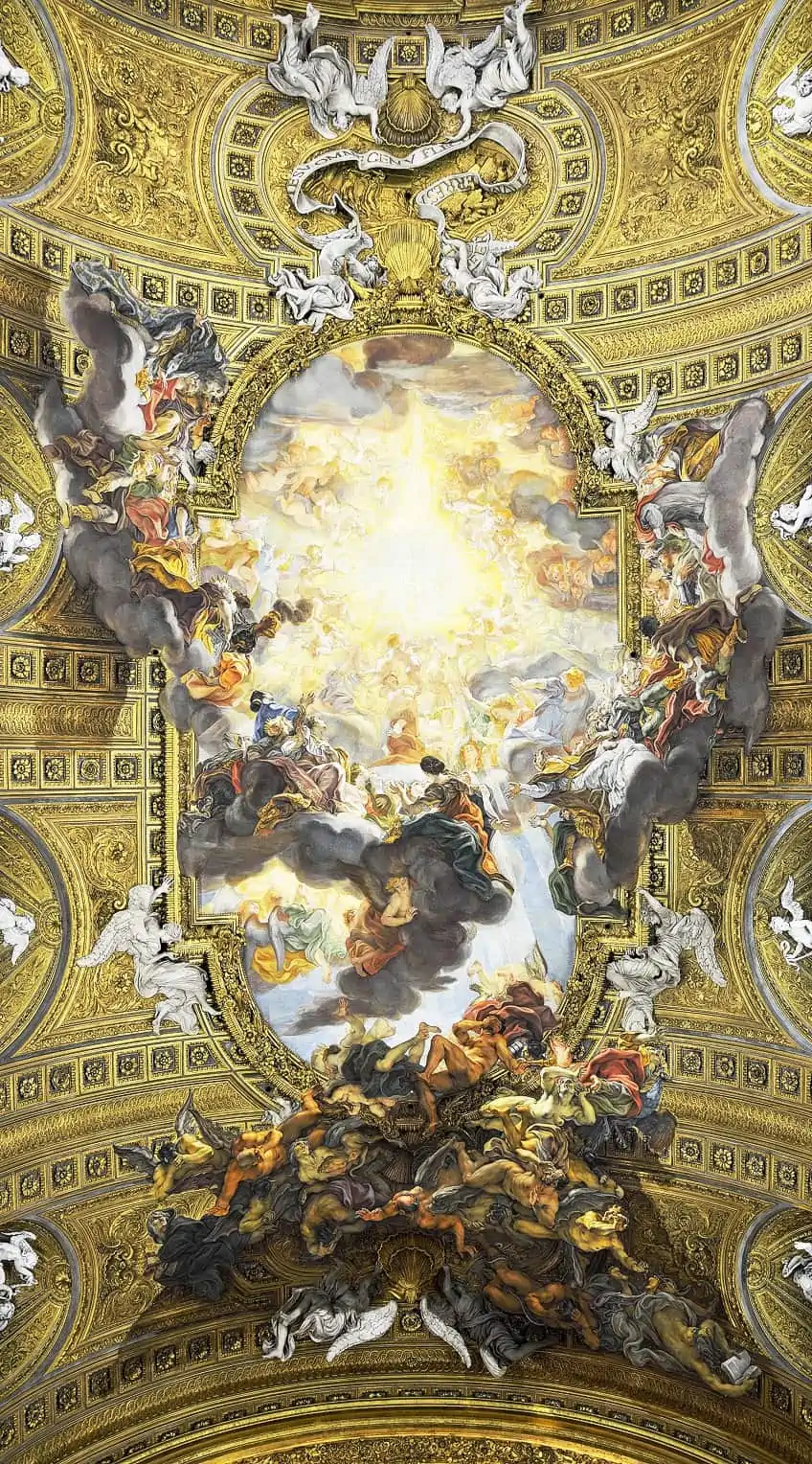
The fresco can be understood in three parts; the heavenly light and the initials of Christ in the center, the clouds that separate the saved from the damned souls, and the damned souls falling away from the scene. The blessed ones rest on the clouds below the frame and give off the illusion that they have not ascended yet and are still in the church.
All the figures are depicted in human form and serve to grant hope to the audience that salvation was achievable.
Gaulli’s depiction of the damned presents a stark contrast to the blessed ones, who are depicted as creatures with horns, wings, and claws with tormented facial expressions, turning their faces away from the light of the heavens. The Triumph of the Name of Jesus was adapted by Gaulli to extend up towards the illusionary heavens and downwards at the viewers. Bernini contributed to many of the fresco’s important elements, especially the different illusionary directions that the work took in its completion.
Vanitas (1672 – 1676) by Franciscus Gysbrechts
| Artist | Franciscus Gysbrechts (1649 – 1677) |
| Date | 1672 – 1676 |
| Medium | Oil on canvas |
| Dimensions (cm) | 115 x 134 |
| Where It Is Housed | Royal Museum of Fine Arts Antwerp, Antwerp, Belgium |
Flemish painter Franciscus Gysbrechts is one of the most famous painters of the Baroque era who specialized in trompe-l’œil paintings and vanitas still life paintings. The theme of vanitas is a specific genre of painting that serves as a glimpse into the futility of life on earth and the “transience of earthly goods and pursuits”.
Paintings like Gysbrechts’ Vanitas contain stock symbols such as wilting flowers, a skull, musical instruments, and other exclusive objects that are informed by the Christian worldview that the world is a temporary space of fleeting joy and sorrow and can only be escaped from through Christ’s sacrifice and the resurrection.

The term vanitas was derived from the biblical book of Ecclesiastes, Vanitas vanitatum et omnia Vanitas, which translates to Vanity of vanities, all is vain. Most of the symbols in Gysbrechts’ painting refer to the earthly human existence accompanied by pleasure and the transitory nature of life and death.
Other symbols like the rose are ambiguous in meaning and refer to both the brevity of life, eternal life, and the resurrection of Jesus Christ.
Franche-Comté taken for the second time (1681 – 1684) by Charles Le Brun
| Artist | Charles le Brun (1619 – 1690) |
| Date | 1681 – 1684 |
| Medium | Fresco |
| Dimensions (cm) | 93 x 140 |
| Where It Is Housed | Palace of Versaille, Versailles, France |
Recognized as one of the most diverse French painters in Western history, Charles le Brun is a famous French Baroque artist whose legacy includes patrons such as King Louis XIV and a well-established repertoire of serving as a top portrait artist and master of altarpieces and battle scenes.
His best paintings can be found at Versailles, France, and at the Louvre in Paris and include the above painting, Franche-Comté taken for the second time (1681 – 1684).
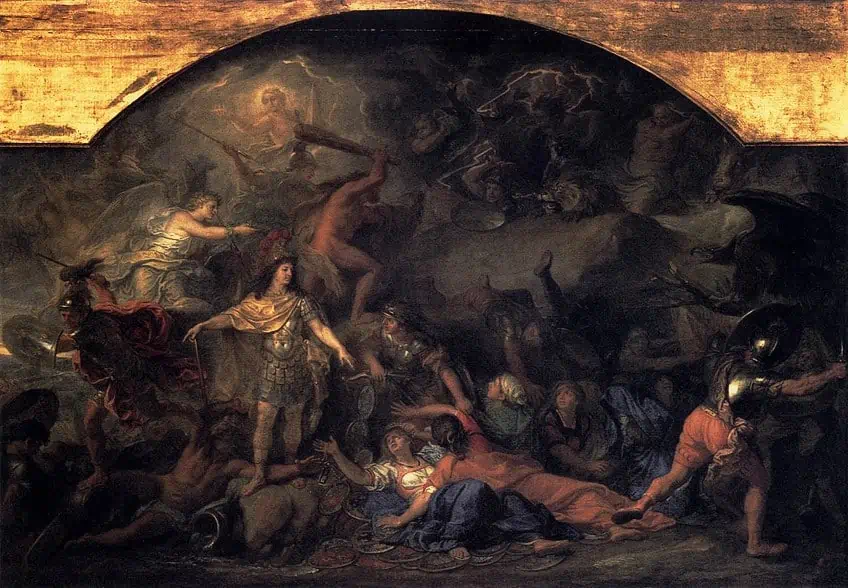
Despite his reputation facing blows in the aftermath of the French Revolution, his reputation seemed to be restored in 1963 when his work was reassessed in Versailles. The painting, showing the Franche-Comté region, was conquered during the War of Devolution in 1668 and the battles took place over 15 days. The area was then reconquered in 1674 after the Treaty of Aix-la-Chapelle when it became a part of France.
The painting shows the King in an immobile state in the midst of a chaotic battle with the two grieving women serving as symbols for the conquered towns.
The women are seen being dragged by Mars to the King, who presents the monarch with their coats of arms. In the background, one can see the mythological figures, Minerva and Hercules, climbing the rock, which is representative of the citadel of Besançon.
Apotheosis of St Ignatius (1688 – 1694) by Andrea Pozzo
| Artist | Brother Andrea Pozzo S. J. (1642 – 1709) |
| Date | 1688 – 1694 |
| Medium | Fresco |
| Dimensions (m) | 17 (d) |
| Where It Is Housed | Church of St. Ignatius of Loyola, Rome, Italy |
Andrea Pozzo was an Italian Jesuit member and one of the most famous Baroque painters of the 17th century. Pozzo’s artistic career was built on his mastery of the quadratura technique to produce the illusion of three-dimensional space on a flat surface. The quadratura technique involved the integration of different perspective techniques to create an illusionary ceiling painting. This painting, executed on a 17-meter diameter surface, is considered one of Pozzo’s best masterpieces.
This grandiose fresco was made for the Roman Church of St. Ignatius. Pozzo’s refined use of these painting techniques solidified his legacy as one of the best Baroque artists of all time.
The masterpiece was created on the dome-shaped ceiling of the church and was painted between 1685 and 1694. The massive painting is considered a key example of the height of High Roman Baroque art and set the standard for several generations to follow. The Church of Sant’Ignazio was unfinished when Pozzo stepped in to resolve the crisis and presented his plan to create an illusion of a dome structure when viewed on the interior by painting directly onto canvas.
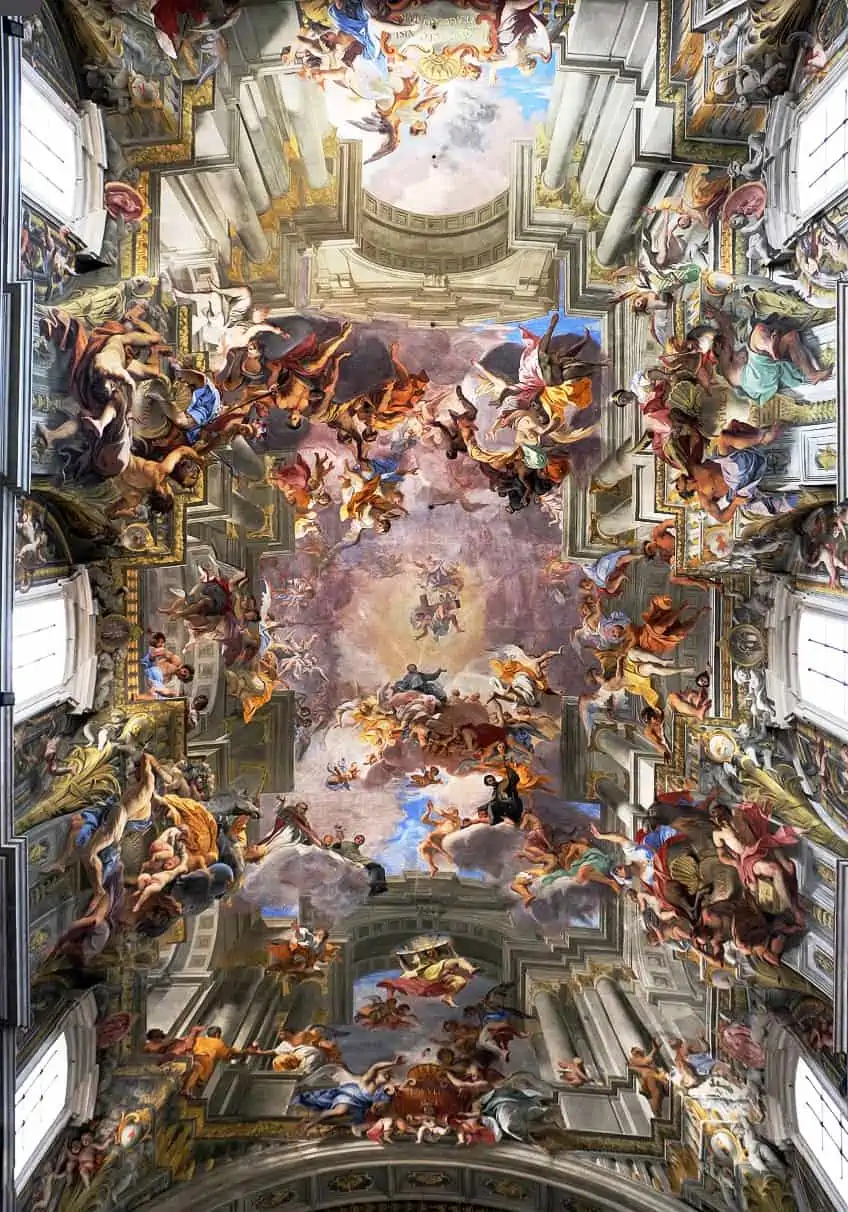
The work was subject to controversy as there were concerns that the canvas would soon change color. The painting depicts an allegory of the Apotheosis of St Ignatius on a flat ceiling. The painting was cleverly designed to make the viewer believe that they were looking at a ceiling with depth. The painting is a celebration of the apostolic goals of the Jesuit believers who were keen on expanding their influence to other continents.
Pozzo did not depict the traditional figures of evangelists, rather, he depicted figures from the Old Testament such as David and Goliath, Judith and Holofernes, and Samson and the Philistines.
The painting also served as a benchmark for other churches of the Jesuit order across Germany, Austria, and Central Europe. The fresco in the nave shows the light emanating from God to the Son who passes it on to St. Ignatius and thereafter spreads out into four rays that direct your attention to the four continents. Pozzo’s focus on movement and a whirling assembly of figures with a deep perspective expanded the architecture and erased the ceiling in such a realistic manner that the architecture was difficult to distinguish as being flat or not. Various scenes from the lives of St. Ignatius, St. Francis Borgia, and St. Francis Xavier is also depicted.
Famous Baroque Portraits
We have caught a glimpse into the top 10 most famous Baroque paintings above but there are also some significant portraits to look at! Here are a few famous Baroque portraits by influential painters that have left a long-lasting impact on the genre of portraiture.
Self-Portrait with a Sunflower (1632 – 1633) by Anthony van Dyck
| Artist | Sir Anthony van Dyck (1599 – 1641) |
| Date | 1632 – 1633 |
| Medium | Oil on canvas |
| Dimensions (cm) | 73 x 60 |
| Where It Is Housed | Eaton Hall, Cheshire, United Kingdom |
Painted between 1632 and 1633, this famous Baroque portrait by Flemish artist Anthony van Dyck is a well-known self-portrait of the artist with a sunflower and gold chain. Anthony van Dyck had many admirers, including individuals like King Charles I, who hired him as a court painter. The portrait shows the artist glancing over his shoulder while staring at the viewer in a calm yet startled manner, as though an onlooker caught him off guard.
Van Dyck’s right hand is seen caressing the petals of a bright yellow sunflower while his left hand holds a long gold chain that extends across his body.
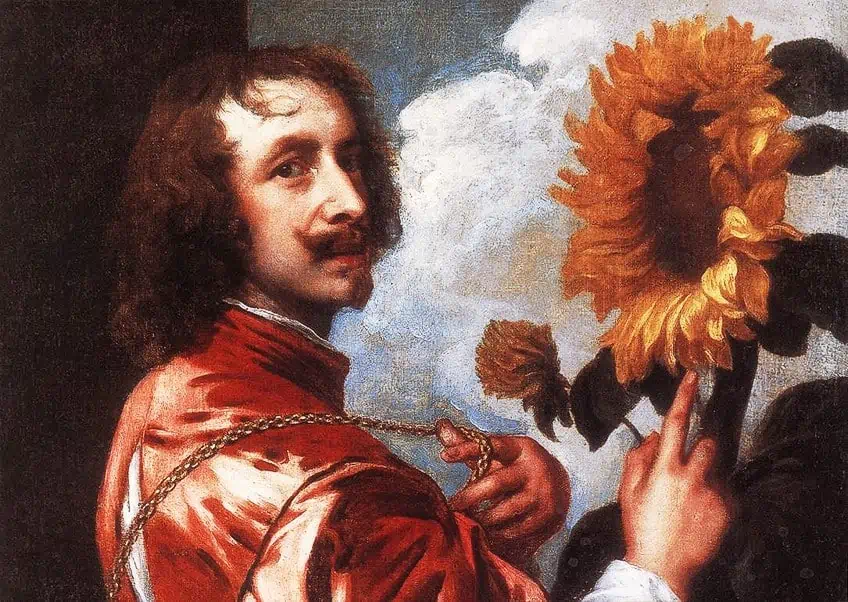
This visual composition allows the viewer’s eye to be drawn toward the chain and portrays a message over which many still debate. The chain was supposedly a gift to the artist from Charles I and attached to the chain is a medal with the patron’s likeness on it. This part is somewhat hidden and unclear since it is covered by Van Dyck’s right sleeve.
It is believed the setting is outdoors as seen in the clouds present in the background.
The artist is also dressed in a pink overcoat with a visible white shirt, as seen through the lengthy slit on his back. The light emanates from the bottom left corner and highlights the outer parts of the sunflower’s petals. This is what makes the sunflower appear as though it is shining on the artist’s face, in approval of him. During this time, Anthony van Dyck served as the principal painter who was highly favored by the court and the King.
Self-Portrait as the Allegory of Painting (1638 – 1639) by Artemisia Gentileschi
| Artist | Artemisia Lomi/Artemisia Gentileschi (1593 – 1653) |
| Date | 1638 – 1639 |
| Medium | Oil on canvas |
| Dimensions (cm) | 98.6 x 75.2 |
| Where It Is Housed | Royal Collection Trust, United Kingdom |
Famous Italian Baroque artist Artemisia Gentileschi produced one of the most famous Baroque portraits in the world for Charles I between 1638 and 1639. Gentileschi was one of the most accomplished artists of her time and began her professional artistic career at the young age of 15 and during a time when many young women were restricted by societal expectations and norms.
Gentileschi was also the first woman to join the Accademia di Arte del Disegno where she soon acquired a global client base.
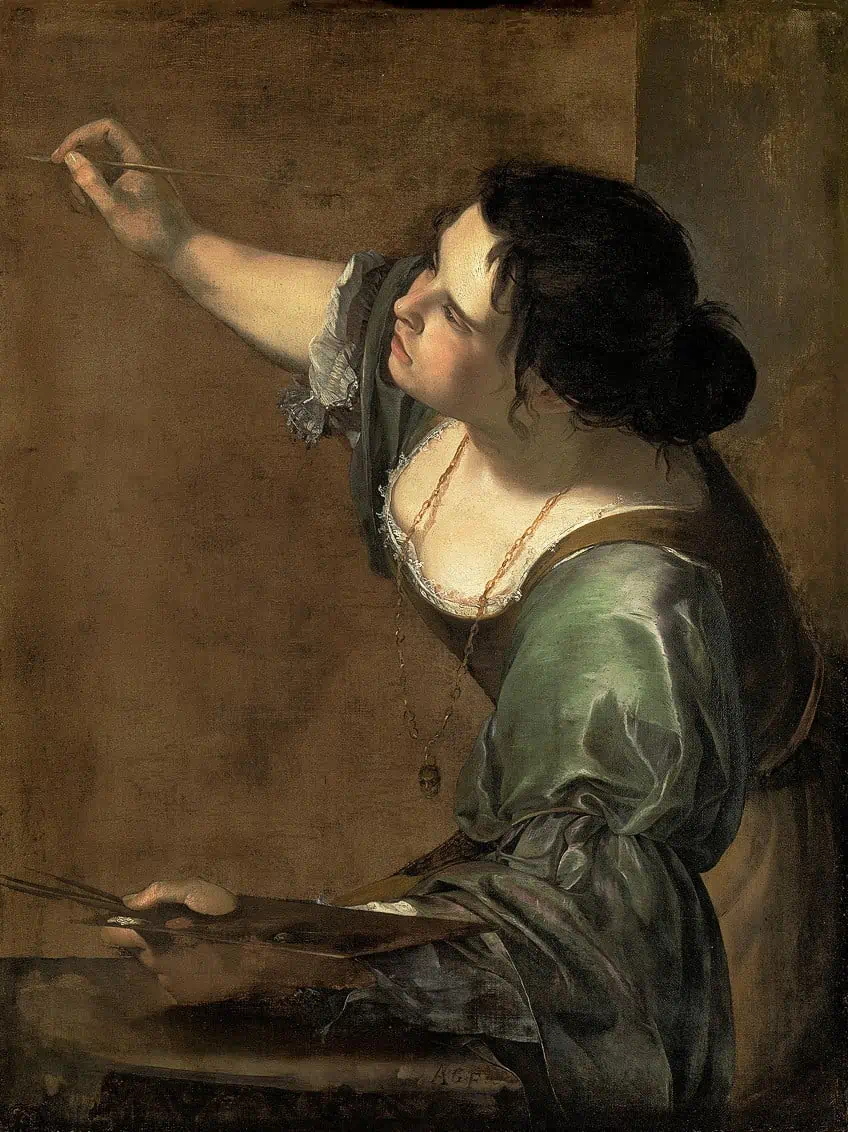
In 1638, Gentileschi was invited to London by Charles I where she created this famous Baroque portrait depicting herself holding a palette and paintbrush in either hand while identifying herself as the personified version of the painting itself. The painting was described as an allegorical figure of painting as recorded in Charles’ inventory.
Her self-portrait is also a classical representation of the Iconologia of Cesare Ripa, which describes the painting as a “beautiful woman with disheveled black hair and arched eyebrows showing imaginative thinking”.
The description further states that the woman’s mouth is covered with a cloth, which is tied behind her ears and she has a gold chain with a mask hanging from her neck. Written on it, is the word “imitation”. Gentileschi includes the majority of the key elements and leaves out the woman’s gag and inscribed mask, which was another way of saying that painting was not a smart act. Gentileschi glorifies her position as an artist engaged in painting as a figure of the act itself.
The Man with the Golden Helmet (c. 1650) by Circle of Rembrandt van Rijn
| Artist | Circle of Rembrandt Harmenszoon van Rijn (1606 – 1669) |
| Date | c. 1650 |
| Medium | Oil on canvas |
| Dimensions (cm) | 68 x 51 |
| Where It Is Housed | Gemäldegalerie, Berlin, Germany |
This famous Baroque-period artwork is said to have once been attributed to the great Rembrandt himself but was later discovered to perhaps be created by an associate or someone in his circle around 1650. This oil on canvas portrait depicts an old man positioned in front of a dark background adorned in a golden helmet.
The helmet is said to be the primary focal point in the portrait due to the artist’s emphasis on light, color, and impasto technique that only halfway illuminated the sitter’s face.
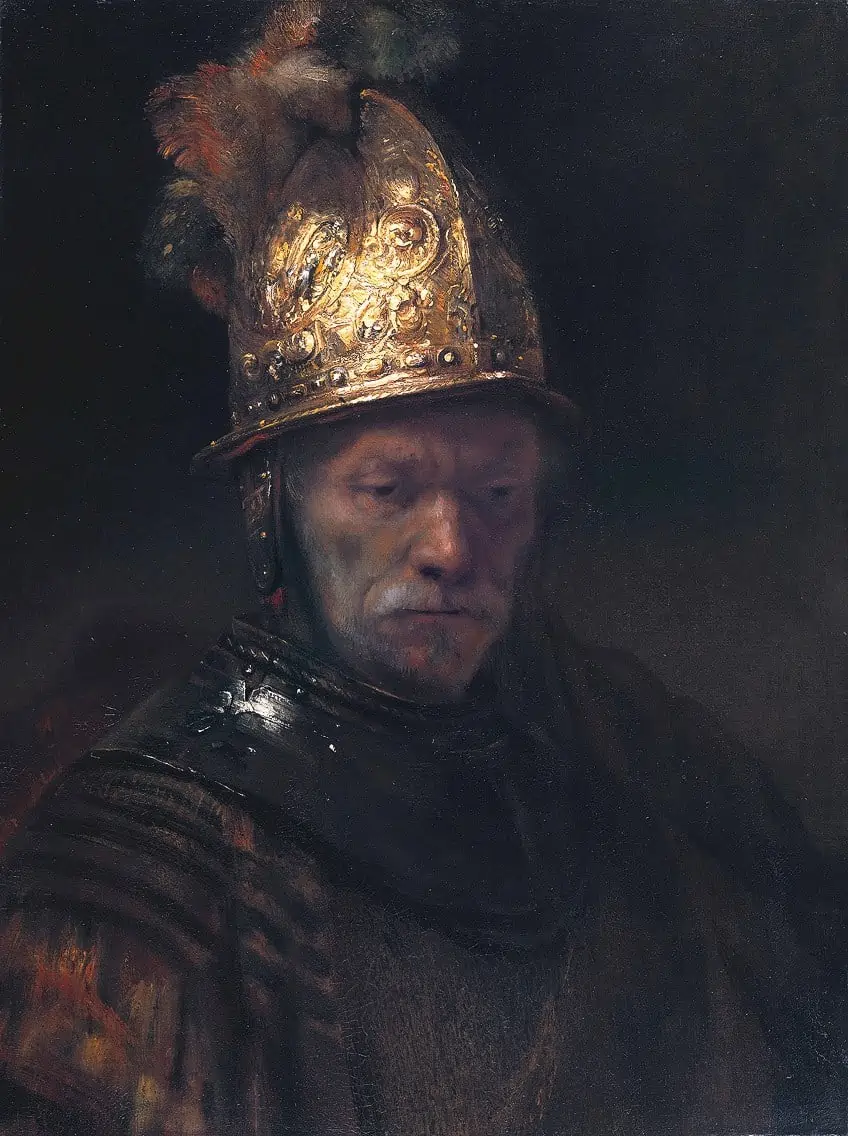
In 1948, doubts arose around the true painter of The Man with the Golden Helmet and an investigation ensued after a Dutch curator viewed the work in West Berlin and questioned its authenticity. Around 1985, Jan Kelch, an art expert clarified the painting’s authenticity by pointing out that crucial details regarding the style of the painting did not match that of Rembrandt’s works at the time and that it was most likely painted by one of his students.
To this day, the painting remains a famous Baroque portrait.
Other Influential Baroque Painters
Aside from the popular Baroque painters and paintings mentioned above, a few other influential Baroque painters include artists like Giovanni Lanfranco, Guercino, Ciro Ferri, Guido Reni, Domenico Zampieri, Sacchi, Francisco de Zurbarán, and Carlo Maratta. One of the most well-known painters of the Roman High Baroque included Pietro da Cortona who saw several papal reigns and executed many paintings during the 1620s for the Sacchetti family and the Palazzo Barberini.
Many famous Baroque-period artworks provide much insight into the trends and artistic preferences of the 17th century. It is evident that the focal point of the century was the manipulation of light, contrast, movement, drama, and color to reinvent daily human life and reintroduce more human emotion into art that was previously unexplored. 17th-century art serves as an important area of study for exploring the humanization of art, which influenced many great masters in Western art history.
Take a look at our Baroque paintings webstory here!
Frequently Asked Questions
What Is Baroque in Painting?
Baroque painting refers to the 17th-century painting style that is defined by the use of different methods of painting to highlight movement, drama, contrast, and human emotion in painting.
Who Is the Most Important Baroque Painter?
The most important Baroque painter is considered to be Michelangelo Merisi Caravaggio, who is also dubbed as the father of Baroque painting.
What Are the Characteristics of Baroque Art?
The characteristics of Baroque art include the presence of direct and dramatic imagery, elements that involve the viewer’s participation, ornamentation, stark contrasts between darkness and lightness, shadow and light, elements alluding to movement, the presence of wind, as well as warm and deep tones of colors such as red, brown, and orange.
Jordan Anthony is a Cape Town-based film photographer, curator, and arts writer. She holds a Bachelor of Art in Fine Arts from the University of the Witwatersrand, Johannesburg, where she explored themes like healing, identity, dreams, and intuitive creation in her Contemporary art practice. Jordan has collaborated with various local art institutions, including the KZNSA Gallery in Durban, the Turbine Art Fair, and the Wits Art Museum. Her photography focuses on abstract color manipulations, portraiture, candid shots, and urban landscapes. She’s intrigued by philosophy, memory, and esotericism, drawing inspiration from Surrealism, Fluxus, and ancient civilizations, as well as childhood influences and found objects. Jordan is working for artfilemagazine since 2022 and writes blog posts about art history and photography.
Learn more about Jordan Anthony and about us.
Cite this Article
Jordan, Anthony, “Famous Baroque Paintings – The Best Baroque Period Artworks.” artfilemagazine – Your Online Art Source. October 20, 2022. URL: https://artfilemagazine.com/famous-baroque-paintings/
Anthony, J. (2022, 20 October). Famous Baroque Paintings – The Best Baroque Period Artworks. artfilemagazine – Your Online Art Source. https://artfilemagazine.com/famous-baroque-paintings/
Anthony, Jordan. “Famous Baroque Paintings – The Best Baroque Period Artworks.” artfilemagazine – Your Online Art Source, October 20, 2022. https://artfilemagazine.com/famous-baroque-paintings/.


